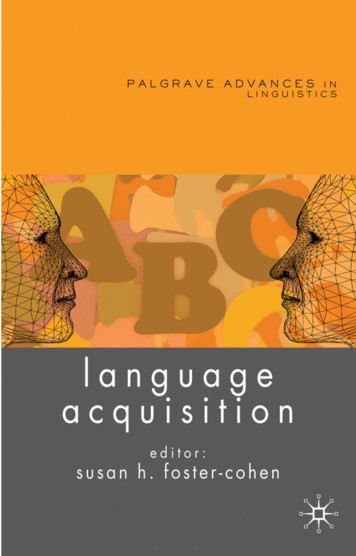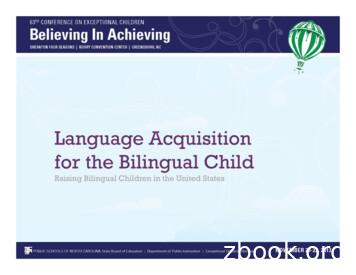Child Language Acquisition - University Of Wisconsin–Madison
Child First Language Acquisition:Young Children TalkingChild LanguageAcquisition 3 months 18 months 6 months 24 monthsFirst and Second 9 months 36 months 12 months2Child First Language Acquisition Babbling Words SoundsIs Language Behavior?and Pronunciation Syntax Morphology3Is Language Behavior? Is Language Behavior? Predictionsof behaviorism for firstlanguage acquisition:B.F. Skinner (1904-1990)claimed that language isjust another form ofbehavior. It is a responseto stimuli in theenvironment. And it islearned.– Children would make many errors.– Errors would differ from child to child.Children’s creativity withlanguage is a problem forthis theory.5– The level of linguistic attainment would differfrom child to child.61
Behaviorist Learning I Ivan Pavlov (18491936) discoveredClassicalConditioning: Learning is theinvoluntaryassociation ofstimulus andresponse.78Behaviorist Learning I1.2.3. Behaviorist Learning INeutral stimulus: Bell ringsUnconditioned stimulus: Present foodUnconditioned response: The dogsalivatesConditioning: Repeat the bell ringing andfood presentation several times.After conditioning: The dog hears a belland then the dog salivates. Pavlov’s Classic Conditioning: Learning is theassociation of stimulus and response.1. Neutral stimulus: Bell rings2. Unconditioned stimulus: Present food3. Unconditioned response: The dog salivates Conditioning: Repeat the bell ringing and foodpresentation several times.After conditioning: The dog hears a bell andthen the dog salivates even when no food ispresented.910Behaviorist Learning of Language? Adult utters “water” whenever the childsees water.– Unconditioned stimulus: “water”– Unconditioned response: the child . . .Drinks? Splashes? Spits? After conditioning:– Conditioned stimulus: the word “water”– Conditioned response: The child drinks.11122
Behaviorist Learning II B.F.Behaviorist Learning IISkinner’s Operant Conditioning:A hungry pigeon is placed in a box.When, by chance, the pigeon pecks a key inthe box, it receives food.1.2.– Learning in which a voluntary response isstrengthened or weakened, depending on itspositive or negative consequences Eventually, the pigeon pecks the keycontinuously until its hunger is satisfied.3.– Works with voluntary muscles only, incontrast to Pavlov’s classical conditioning.The first time this happens the pigeon does notlearn the connection between pecking and receivingfood. The pigeon demonstrates that it has learned theconnection between stimulus and response.1314Behaviorist Learning II Shaping is the process of teaching acomplex behavior by rewarding closerand closer approximations to the desiredbehavior.1. Reinforce any behavior that is similar to thebehavior you want.2. Reinforce only those behaviors that areclose to the desired behavior.3. Reinforce only the desired response.1516Behaviorist Learning of Language? Adults train the child to say “water”when it sees water.1. Reinforce “wa”, “wawa”, etc.2. Reinforce “wada”3. Reinforce only “water”17183
Operant ConditioningChild First Language Acquisition Children’screativity with language is aproblem for behaviorist theories oflanguage learning. JeanBerko and the “wugs”- The child’s learning of English morphology.Word, 14, 150-177, 1958.1920Now there are two of them.Two ?This is a wug.2122This is a bird who knows how torick. It is ricking.Two wugs244
What did it do yesterday?Yesterday it .Yesterday it ricked.25This is a frog who knows how tomot. He is motting right now.What did he do yesterday?Yesterday he .2728This is a little wug. What wouldyou call such a small wug?Yesterday he motted.305
This wug lives in a house. Whatwould you call a house that a wuglives in?A wuglet32What Can We LearnFrom The Wugs? A wugwamThe major finding of the wug test was that evenvery young children have already internalizedsystematic aspects of the linguistic system thatenable them to produce plurals, past tenses,possessives, and other forms of words that theyhave never heard before. The test has beenreplicated many times, and it has proven veryrobust. It was the first experimental proof thatyoung children have extracted generalizablerules from the language around them.34The First Longitudinal Study ofChild Language Acquisition The First Longitudinal Study ofChild Language AcquisitionRoger Brown undertook a landmark study of thelinguistic development of children. He focusedon three children, whom he called Adam, Eve,and Sarah. In this monumental study, and onthe basis of careful examination of thesechildren's utterances, he established empiricalgeneralizations for the way in which anylanguage is acquired.A first language: The early stages. Cambridge,Mass., Harvard University Press, 1973.35 Adam was studied by Brown from the age of 2years and 3 months (2;3) for 15 months. Sarah was studied by Brown from the age of 2years and 3 months (2;3) for 21 months. Eve was studied by Brown from the age of 1year 6 months (1;6) for 15 months.366
Adam’s Acquisition of 14MorphemesSarah’s Acquisition of 14MorphemesStageIStage Age MorphemesI2;3II2;6 Present progressiveinonpluralIIIIIIII2;11 Uncontractible copulaPast irregularIV3;2 Articles3rd person irregularPossessiveV3;6 3rd person regularPast regularUncontractible auxiliaryContractible copulaContractible auxiliaryAge Morphemes2;32;10 Pluralin, onPresent progressive, Past irregular, Possessive3;1Uncontractible copulaArticlesIV3;8V4;03rd person regular37Past regularUncontractible auxiliaryContractible copula3rd person irregularContractible auxiliary38Eve’s Acquisition of 14 MorphemesIs the Order of Acquisitionthe Same for the ThreeChildren?Stage Age MorphemesI1;6IIIIIIVV1;9 Present progessiveon1;11 inPlural2;2 Possessive, Past regular2;3 Uncontractible copulaPast irregularArticles3rd person regular3rd person irregularUncontractible auxiliaryContractible copulaContractible auxiliary39AdamStage Age MorphemesSarahStage Age MorphemesEveStage Age MorphemesI1;6IIIIII2;3II2;6 Present progressiveinonpluralIII2;11 Uncontractible copulaPast irregularIV3;2 Articles3rd person irregularPossessiveV3;6 3rd person regularPast regularUncontractible auxiliaryContractible copulaContractible auxiliaryIVVI2;3II2;10 Pluralin, onPresent progressive, Past irregular, Possessive3;1Uncontractible copulaArticlesIIIIV3;8V4;0 Past regularUncontractible auxiliaryContractible copula3rd person irregularContractible auxiliaryChild Second Language Acquisition1;9 Present progessiveon1;11 inPlural2;2 Possessive, Past regular2;3 Uncontractible copulaPast irregularArticles3rd person regular3rd person irregularUncontractible auxiliaryContractible copulaContractible auxiliary TheMorpheme Order Studies– The Bilingual Syntax Measure3rd person regular41427
Spanish-Speaking Children in ThreeDifferent CitiesThe Bilingual Syntax Measure43Spanish- and Cantonese-speakingChildren44Adults and Children4546A Natural Order for the AcquisitionMorphemes in English as a L2?In Speech and In WritingPROGRESSIVE – ingPLURAL – sCOPULA is/are47488
A Natural Order for the AcquisitionMorphemes in English as a L2?A Natural Order for the AcquisitionMorphemes in English as a L2?PROGRESSIVE – ingPLURAL – sCOPULA is/are PROGRESSIVE – ingPLURAL – sCOPULA is/are AUXILIARY is/are/haveAUXILIARY is/are/have 3rd49PERSON SINGULAR – sPOSSESSIVE – s509
Child First Language Acquisition Babbling Words Sounds and Pronunciation Syntax Morphology Is Language Behavior? 5 Is Language Behavior? B.F. Skinner (1904-1990) claimed that language is just another form of behavior. It is a response to stimuli in the environment. And it is learned. Children’s creativity with language is a problem for this .
3. the inevitability of child directed speech 62 matthew saxton 4. universal grammar approaches to language acquisition 87 maria teresa guasti 5. second language acquisition 109 susan gass part 2. windows on language acquisition 6. language and the many faces of emotion 143 judy s. reilly 9780230_500303_01_prexx.indd v 4/15/2009 8:43:26 PM. vi language acquisition 7. complements enable .
Understanding Child Language Acquisition Taking an accessible and cross-linguistic approach, Understanding Child Language Acquisition introduces readers to the most important research on child language acquisition over the last fifty years, as well as to some of the most influential theories in the field. Rather than just describing what children can do at different ages, Rowland explains .
Language Acquisition Module 1: First language acquisition, second language acquisition, bilingualism: definitions, differences and similarities "When we study human language, we are approaching what some might call the human essence, the distinctive qualities of mind that are, so far as we know, unique to [humans]." (Chomsky, 1968, p. 100)
The influence factors of second language acquisition . The main factors that affect second language acquisition. Individual factors of learners . The main process of second language acquisition includes perception, understanding, consolidation and application is very important for the study of the second language acquisition ,it .
Care needed: (check all that apply) Child #1 Child #2 Child #3 Child #4 Child #5 Preferred Location (Zip Code other than home) Full day Part day Evenings Overnight Weekends Special Needs: Child #1 Child #2 Child #3 Child #4 Child #5 Limited English Child Protective Services Severely Handicapped
Simultaneous acquisition (dual language exposure) A child under the age of three who is exposed to two langgguages usually experiences simultaneous acquisition. Successive acquisition If a child is exposed to the second language at an older age (o
Second Language Acquisition (SLA) refers to the study of how students learn a second language (L2) additionally to their first language (L1). Although it is referred as Second Language Acquisition, it is the process of learning any language after the first language whether it is the second, third
Attila has been an Authorized AutoCAD Architecture Instructor since 2008 and teaching AutoCAD Architecture software to future architects at the Department of Architectural Representation of Budapest University of Technology and Economics in Hungary. He also took part in creating various tutorial materials for architecture students. Currently he .























